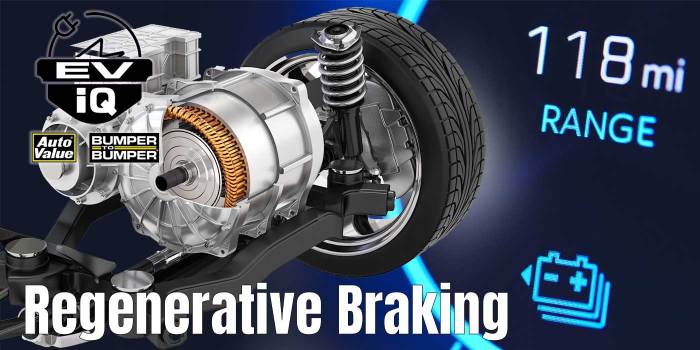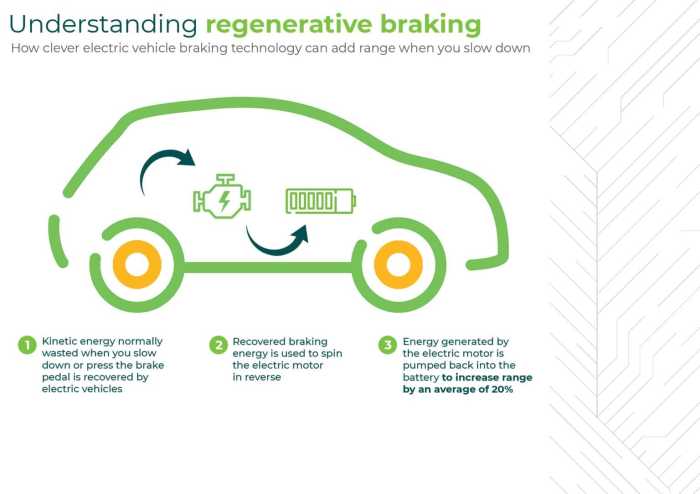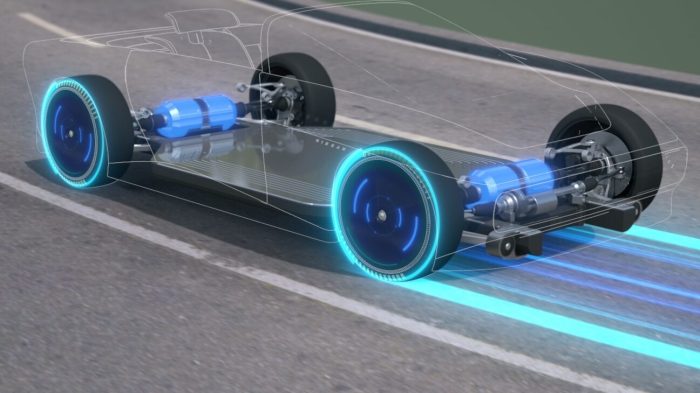How to disable EV regenerative braking? That’s a question more EV drivers are asking as they get comfy behind the wheel. Regenerative braking, that sweet feeling of the car slowing down and recharging your battery, isn’t always ideal. Sometimes you just want that good old-fashioned friction braking. This guide breaks down how to find those settings in your ride, what the trade-offs are, and what you should keep in mind before messing with your car’s braking system.
We’ll cover everything from locating the settings on different EV models (think Tesla, Chevy Bolt, and Ford Mustang Mach-E – we’ve got you covered!), to understanding the potential impact on your battery life and range. We’ll even touch on some of the safety considerations and any potential warranty issues. Buckle up, it’s going to be a fun ride (pun intended!).
Understanding Regenerative Braking in EVs: How To Disable EV Regenerative Braking

Regenerative braking is a pretty cool feature in electric vehicles (EVs) that helps improve efficiency and performance. It essentially turns your car’s motor into a generator, recovering energy that would otherwise be lost as heat during braking. This recovered energy is then stored back in the battery, extending your driving range.Regenerative braking works by reversing the motor’s operation.
When you lift off the accelerator or press the brake pedal (depending on the system’s design), the motor switches from driving the wheels to acting as a generator. The rotating wheels turn the motor, generating electricity. This electricity flows back into the battery, replenishing its charge. The amount of regenerative braking applied can vary, often controlled by the driver through different driving modes or settings.
Mechanics of Regenerative Braking
The process starts with the driver initiating braking. This could be through easing off the accelerator pedal (often referred to as “one-pedal driving”), applying the brake pedal lightly, or a combination of both. The vehicle’s control system then determines how much regenerative braking to apply, adjusting the motor’s behavior to generate electricity. The generated electricity is then converted and stored in the battery.
The intensity of the regenerative braking is adjusted to provide a smooth and controlled deceleration, blending seamlessly with traditional friction braking when needed for complete stopping power. Sophisticated algorithms manage this transition to ensure a safe and comfortable driving experience.
Benefits of Regenerative Braking Systems
Regenerative braking offers several key advantages. Firstly, it significantly improves the overall efficiency of the EV. By recovering energy during braking, it reduces the amount of energy drawn from the battery, leading to increased range. Secondly, it contributes to reduced wear and tear on the friction brakes. Since regenerative braking handles a significant portion of the braking effort, the friction brakes are used less frequently, extending their lifespan and reducing the need for replacements.
Thirdly, it enhances the driving experience, especially in city driving, by providing a smoother and more responsive braking feel. The ability to slow down or even stop the vehicle using only the accelerator pedal in some cases contributes to a more efficient and relaxed driving style. Finally, regenerative braking contributes to a lower overall carbon footprint of the vehicle, as less energy needs to be drawn from the power grid to recharge the battery.
Comparison of Regenerative and Friction Braking
Regenerative and friction braking are fundamentally different. Friction braking, the traditional method, uses friction pads to slow down the wheels by converting kinetic energy into heat, which is then dissipated into the environment. This process is inherently less efficient, as the energy is lost as waste heat. In contrast, regenerative braking converts kinetic energy into electricity, which is stored and reused, making it far more energy-efficient.
While regenerative braking can handle a significant portion of braking, it typically cannot bring the vehicle to a complete stop alone. Friction brakes are always present as a backup for full stopping power and for emergency situations. The two systems work together, complementing each other to provide a safe and efficient braking experience.
Identifying Regenerative Braking Settings
Finding the regenerative braking settings in your EV can feel like a scavenger hunt sometimes, but it’s usually pretty straightforward once you know where to look. The location and method of adjustment vary significantly between manufacturers, and even within model years of the same manufacturer. This is because each automaker has its own approach to user interface design.Regenerative braking settings are typically found within the vehicle’s infotainment system or driver assistance menus.
Sometimes they are buried deep within the settings, other times prominently displayed. Let’s look at some examples.
Regenerative Braking Settings in Different EV Models
Different manufacturers employ varying approaches to presenting and adjusting regenerative braking settings. The placement and terminology used can differ considerably. Below, we’ll explore three common examples, illustrating the diversity you might encounter.
| Manufacturer | Location of Settings | Interface Description | Typical Adjustment Options |
|---|---|---|---|
| Tesla | Usually accessed through the touchscreen’s main settings menu, often under a section labeled “Driving” or “Autopilot.” Sometimes it’s nested under “Pedal and Steering.” | Tesla typically uses a slider control. The slider might be accompanied by textual descriptions such as “Low,” “Medium,” “High,” or percentage values representing the intensity of regenerative braking. A visual representation of the braking strength might also be included, such as a bar graph filling up as the regenerative braking strength increases. | A range from minimal regeneration (similar to engine braking in a gasoline car) to maximum regeneration (providing significant deceleration). Some models allow for “Creep” mode adjustment, which controls how much the car rolls forward at a standstill. |
| Chevrolet | Often found within the vehicle’s infotainment system under a menu labeled “Settings,” then “Vehicle,” and finally a sub-menu related to driving modes or energy management. | Chevrolet may use a series of selectable pre-set modes (e.g., “Low,” “Medium,” “High,” or similar labels) instead of a continuous slider. Each mode offers a different level of regenerative braking. The screen might display a simple icon representing the selected level. | Discrete levels of regenerative braking intensity. The exact number of levels and their corresponding braking strengths vary depending on the model and year. |
| Ford | The location can vary across Ford’s EV lineup, but it’s generally accessible through the central touchscreen’s settings menu, often under a section called “Vehicle” or “Driving.” | Ford might use a combination of a slider and pre-set modes. The slider allows for fine-tuning within a selected mode. The display could show a graphic indicating the current level of regenerative braking strength, perhaps with a visual representation of energy recovery. | A combination of pre-set modes (e.g., “One-Pedal Driving,” “Standard”) and a slider for adjusting within those modes. One-Pedal Driving usually implies maximum regeneration. |
Methods for Disabling or Reducing Regenerative Braking
So, you’ve got your electric vehicle and you’re ready to roll, but that regenerative braking is a little too aggressive for your taste? Don’t worry, you’re not alone. Many EV drivers find adjusting the level of regenerative braking improves their driving experience. Luckily, most EVs offer ways to tweak or completely turn off this feature. Let’s explore the options.Many modern EVs provide in-car controls to adjust the strength of regenerative braking.
This usually involves navigating through the infotainment system’s menus. These settings are often presented as selectable levels, ranging from “Low” or “Minimal” to “High” or “Max,” or even a customizable setting. Some manufacturers might label these modes differently, using terms like “One-Pedal Driving” for a higher regeneration setting and “Standard” or “Coast” for a lower setting. The exact location and terminology of these settings will vary greatly depending on the make and model of your vehicle.
In-Car Control Adjustments
Adjusting regenerative braking via the in-car controls is generally the safest and easiest method. The process typically involves accessing a specific menu within the car’s infotainment system, often found under settings related to driving modes, powertrain, or vehicle dynamics. Once located, you’ll find options to select a different regenerative braking level or completely disable it. The changes take effect immediately, allowing you to instantly feel the difference in braking behavior.
This is the recommended approach, as it’s designed and tested by the vehicle manufacturer, ensuring compatibility and safety.
Third-Party Software or Modifications
Modifying regenerative braking through third-party software or hardware modifications is generally not recommended. These methods are often untested and may void your vehicle’s warranty. Furthermore, altering the vehicle’s braking system without proper knowledge could lead to unpredictable and potentially dangerous outcomes. While some aftermarket tuning companies may offer such modifications, proceed with extreme caution and only consider reputable companies with a proven track record.
Even then, the risks involved often outweigh the potential benefits. Always prioritize safety and reliability over performance enhancements in this context. There’s also the potential for legal complications if modifications interfere with safety regulations or emissions standards.
Limitations and Risks Associated with Disabling Regenerative Braking
Completely disabling regenerative braking means losing the energy recovery aspect of the system. This leads to reduced overall efficiency and, consequently, lower range. You might also find yourself relying more heavily on the friction brakes, which can lead to increased brake wear. It’s crucial to understand that the behavior of the vehicle will change significantly; you’ll experience a less responsive braking feel and may need to adapt your driving style to compensate.
Remember that the regenerative braking system is an integral part of the overall braking system design in many EVs, and altering it can have unforeseen consequences.
Impact on Driving Experience
Switching between regenerative braking enabled and disabled modes significantly alters the driving experience in an EV. The primary difference lies in how the car decelerates and the overall feel of the driving dynamics. With regenerative braking active, the car slows down more noticeably when you lift off the accelerator pedal, essentially using the motor as a generator to recapture energy.
Disabling it leads to a more traditional internal combustion engine (ICE) like driving feel, where coasting is more pronounced.The changes in vehicle behavior are quite perceptible. With regenerative braking enabled, the car exhibits a more pronounced “one-pedal driving” characteristic. This means you can often accomplish most of your braking by simply lifting off the accelerator, relying less on the friction brakes.
This leads to smoother deceleration, especially in city driving, and can improve energy efficiency. However, this can also take some getting used to, as the initial deceleration might feel stronger than drivers accustomed to ICE vehicles expect.
Acceleration and Deceleration Differences
With regenerative braking engaged, deceleration is a blend of motor regeneration and friction braking. The transition between these two braking systems is typically seamless and well-managed by the car’s control systems. When regenerative braking is off, deceleration relies solely on friction brakes, leading to a more traditional and less pronounced deceleration feel when lifting off the accelerator. Acceleration, on the other hand, remains largely unaffected by the regenerative braking setting, though a slight increase in acceleration might be felt with regeneration disabled due to the lack of energy recapture slowing down the motor.
The difference is subtle but noticeable to experienced EV drivers.
Overall Driving Feel and Driver Adaptation
The overall driving feel is significantly different. With regenerative braking active, the driving experience is often described as smoother and more efficient, especially in stop-and-go traffic. The ability to almost exclusively use one pedal for both acceleration and deceleration reduces driver fatigue. However, some drivers may find the initial deceleration too strong or abrupt, requiring an adjustment period. Conversely, with regenerative braking disabled, the driving experience feels more like driving a gasoline-powered car.
Coasting becomes more pronounced, and the driver needs to rely more on the brake pedal for deceleration. This can feel more natural to some drivers accustomed to ICE vehicles, but it can also lead to less efficient energy use. The transition between the two modes is usually smooth, allowing the driver to choose the mode that best suits their driving style and preferences.
Safety Considerations
Disabling or significantly reducing regenerative braking in an EV alters the vehicle’s braking characteristics, introducing potential safety hazards. Understanding these risks is crucial for safe operation. The primary concern revolves around the decreased braking force available and the potential for longer stopping distances.Reduced braking capability necessitates adjustments in driving habits. Drivers accustomed to the significant braking assistance provided by regenerative braking might find themselves relying more heavily on friction brakes in emergency situations.
This increased reliance on friction brakes can lead to brake fade, reduced braking effectiveness, and increased stopping distances, particularly during repeated or prolonged braking. This is especially true during high-speed driving or in challenging weather conditions such as rain or snow where friction is already reduced.
Emergency Braking Implications
The reduced braking force resulting from disabled regenerative braking directly impacts emergency braking scenarios. The driver will need a longer distance to come to a complete stop compared to when regenerative braking is active. This increased stopping distance significantly increases the risk of collision, especially in situations requiring immediate and forceful braking, such as avoiding a sudden obstacle or reacting to a hazardous situation.
The driver’s reaction time, the vehicle’s speed, and road conditions all contribute to the overall stopping distance, and disabling regenerative braking magnifies the impact of each factor. For example, if a driver traveling at 60 mph needs 150 feet to stop with regenerative braking engaged, disabling it could increase that distance to 200 feet or more, depending on factors like tire condition and road surface.
This additional 50 feet could be the difference between a near miss and a serious accident.
Battery and Energy Consumption
Disabling regenerative braking directly impacts how your EV’s battery is charged and discharged, ultimately affecting your overall energy consumption and driving range. Understanding this relationship is crucial for optimizing your EV’s performance and maximizing its efficiency. Essentially, you’re trading some level of energy recapture for a different driving feel.Regenerative braking works by converting kinetic energy (your car’s movement) into electrical energy, which is then used to recharge the battery.
When you disable this feature, that energy is instead lost as heat through friction in the brakes. This means your battery isn’t receiving this supplemental charge, leading to a faster depletion of its existing energy. The extent of this impact varies depending on driving style and conditions. Heavier braking and frequent stops will show a more significant difference in energy consumption with regenerative braking disabled.
Range Impact Under Different Driving Conditions
The table below illustrates the potential impact on range with regenerative braking enabled versus disabled. These figures are estimates and can vary widely based on factors like vehicle model, battery size, driving style, terrain, weather, and even tire pressure. Consider these values as illustrative examples rather than precise predictions. For example, a hilly route with frequent braking will see a larger range reduction when regenerative braking is disabled compared to a flat highway drive.
| Driving Condition | Range with Regenerative Braking Enabled (miles) | Range with Regenerative Braking Disabled (miles) | Percentage Range Reduction |
|---|---|---|---|
| City Driving (heavy braking, frequent stops) | 200 | 170 | 15% |
| Highway Driving (constant speed, minimal braking) | 250 | 240 | 4% |
| Mixed Driving (city and highway) | 225 | 195 | 13% |
| Mountainous Terrain (frequent braking, uphill/downhill) | 180 | 140 | 22% |
Legal and Warranty Implications
Modifying or disabling your EV’s regenerative braking system might seem like a simple tweak, but it carries potential legal and warranty ramifications that are worth understanding before you even consider it. Messing with core vehicle systems can have unintended consequences, and manufacturers are understandably protective of their designs and the safety of their vehicles.The biggest risk is voiding your vehicle’s warranty.
Most EV warranties explicitly state that modifications to the vehicle’s electrical or braking systems will invalidate coverage. This means if something goes wrong with your car – anything from a minor malfunction to a major component failure – the manufacturer may refuse to cover the repairs, leaving you with a hefty bill. This isn’t just about regenerative braking; it applies to any unauthorized modifications that affect the car’s performance or safety.
Warranty Voiding and Repair Costs
The consequences of a voided warranty can be significant. Imagine a scenario where a crucial component related to the braking system fails after you’ve disabled regenerative braking. Without warranty coverage, you’d be responsible for the entire cost of diagnosis and repair, which could easily run into thousands of dollars. This is especially true for complex EV components that require specialized tools and expertise to service.
So, you wanna know how to disable regenerative braking on your EV? It’s usually buried in the settings menu, but honestly, it depends on the make and model. With the push for Zero-emission vehicle (ZEV) mandates 2025 , more EVs are hitting the road, and understanding their features, like regen braking, becomes even more important.
Figuring out how to adjust or turn off that regen braking might be a useful skill as you navigate this growing EV landscape.
The repair cost could potentially exceed the value of the vehicle, depending on the severity of the damage and the age of the car. For example, replacing an electric motor or battery pack, even partially due to a failure linked to a modified braking system, could result in catastrophic financial repercussions.
Legal Liability in Accidents
Disabling a safety feature like regenerative braking could also expose you to legal liability in the event of an accident. If a court determines that the modification contributed to the accident, you could face legal action from other parties involved. Proving a direct causal link might be difficult, but the modification itself could be seen as negligence, potentially impacting the outcome of any legal proceedings.
Insurance companies are also likely to scrutinize modifications and may deny or reduce claims if they believe the modifications contributed to the accident. This could leave you personally liable for significant damages and legal fees.
Troubleshooting Common Issues

So, you’ve been trying to fiddle with your EV’s regenerative braking, and things aren’t going exactly as planned? Don’t worry, it’s more common than you think. Many drivers encounter minor hiccups when adjusting or disabling this feature. Let’s look at some of the most frequent problems and how to fix them.
Troubleshooting regenerative braking issues often involves understanding your specific EV’s interface and settings. The location and functionality of these settings can vary wildly between manufacturers and models. Consulting your owner’s manual is the absolute best first step. Failing to understand your car’s specific system can lead to frustration and potentially incorrect adjustments.
Regenerative Braking Settings Not Appearing in the Menu
This is a pretty common issue. Sometimes, the regenerative braking settings are nested within other menus, or they might only appear under certain driving modes (like “Eco” mode). Other times, the option might be completely absent if your specific EV trim level doesn’t offer adjustable regen.
So, you wanna know how to disable regenerative braking in your EV? It’s usually buried in the settings menu, but honestly, finding it can be a total pain. Check out this article on Augmented reality dashboards in 2025 EVs – maybe future cars will make this easier to find! Hopefully, with AR, digging through menus to disable regen braking will become a thing of the past.
- Check your driving mode: Many EVs offer different driving modes (e.g., Eco, Normal, Sport). Regenerative braking settings are often only adjustable or even available in certain modes. Try switching to “Eco” mode, as this frequently maximizes regen.
- Consult your owner’s manual: The manual will precisely Artikel where to find the regenerative braking settings within your car’s infotainment system. Pay close attention to diagrams and screenshots if provided.
- Software update: In some cases, a software update may be needed to unlock or enable regenerative braking adjustments. Check for available updates through your car’s infotainment system or your manufacturer’s website.
- Contact your dealership: If you’ve exhausted all other options and still can’t find the settings, it’s time to call in the professionals. Your dealership will have the most accurate information about your specific model and its capabilities.
Unexpected Behavior After Adjusting Regenerative Braking
Sometimes, even after finding the settings, you might experience unexpected behavior. The car might feel jerky, or the regenerative braking might be too strong or weak.
- Gradual adjustments: Instead of making large changes at once, try adjusting the regenerative braking settings in small increments. This allows you to better fine-tune the system to your preferences and driving style.
- Test in different conditions: Experiment with the adjusted settings in various driving situations (highway driving, city driving, uphill/downhill) to see how they perform under different conditions. This helps you determine the optimal settings for your needs.
- Reset to factory defaults: If you’re completely lost, resetting the regenerative braking settings to their factory defaults can provide a clean slate. This is usually an option within the vehicle’s settings menu.
- Professional assistance: If the unexpected behavior persists after attempting these troubleshooting steps, seek assistance from a qualified mechanic or your dealership. There might be an underlying mechanical issue affecting the regenerative braking system.
Regenerative Braking System Malfunction
In rare cases, there might be a genuine malfunction with the regenerative braking system.
- Warning lights: Pay attention to any warning lights on your dashboard related to the braking system. These lights often indicate a problem that requires professional attention.
- Reduced braking performance: If you notice a significant reduction in braking performance, even when not using regenerative braking, it’s crucial to have your vehicle inspected immediately by a qualified mechanic.
- Unusual noises: Any unusual noises emanating from the braking system (e.g., grinding, squealing) should be investigated promptly. These sounds often indicate a problem with the braking components.
- Immediate professional service: Any suspected malfunction of the regenerative braking system should be addressed by a qualified mechanic or your dealership immediately. Do not attempt to diagnose or repair the issue yourself, as this could be dangerous.
Advanced Techniques
While most drivers will rarely need to completely disable regenerative braking, understanding the nuances can be beneficial in specific situations. Knowing how to manage or minimize regenerative braking can improve control and safety, particularly in challenging driving conditions. This section explores a hypothetical scenario requiring complete deactivation and Artikels alternative braking methods.A hypothetical scenario where a driver might want to fully disable regenerative braking involves navigating a long, steep, icy downhill descent.
In this case, the subtle application of regenerative braking, even at a low level, could cause the wheels to lose traction on the slick surface, leading to a dangerous skid or loss of control. The unpredictability of the ice and the need for precise control over braking force make complete deactivation of regenerative braking a safer option in this context.
The potential outcome of not disabling regenerative braking in such a scenario could be a loss of control, resulting in an accident.
Icy Descent Braking Strategies, How to disable EV regenerative braking
The driver facing the icy downhill situation described above could employ several alternative braking techniques. The primary method would involve using the friction brakes exclusively. This requires a smooth and controlled application of the brakes to avoid locking the wheels and triggering a skid. Experienced drivers might utilize engine braking (if the vehicle offers it) in conjunction with friction braking, providing additional deceleration control without relying on regenerative braking’s potential for wheel slippage on ice.
Anticipatory driving, such as reducing speed well before the descent and selecting a lower gear (if applicable), also plays a crucial role in managing speed and preventing excessive reliance on braking. The driver’s focus should be on maintaining a slow, steady descent, prioritizing vehicle control over speed. Maintaining a safe following distance is also critical, giving ample time to react to any unexpected events.
Final Review

So, disabling or adjusting your EV’s regenerative braking? It’s totally doable, but it’s a decision that requires careful consideration. Weighing the benefits of a smoother driving experience against potential impacts on range and battery life is key. Remember to always prioritize safety and consult your owner’s manual before making any significant changes to your vehicle’s settings. Happy driving!









